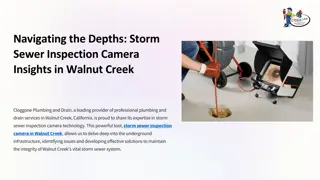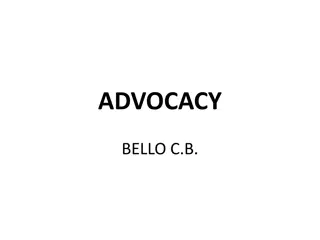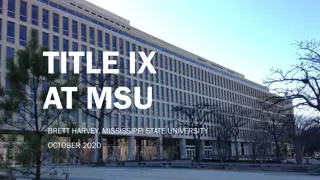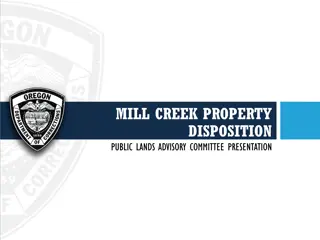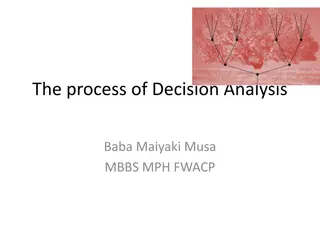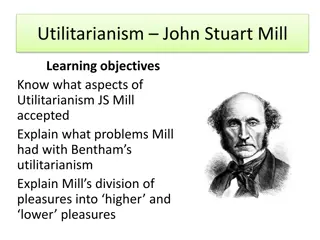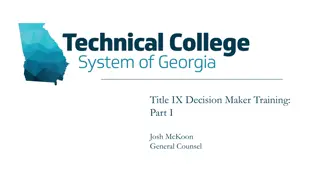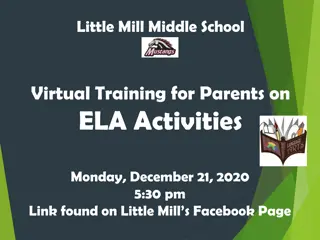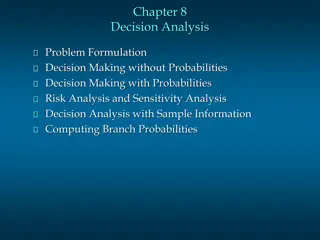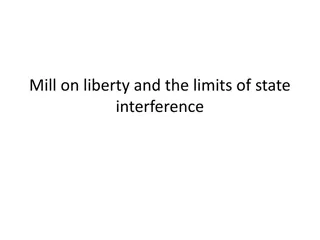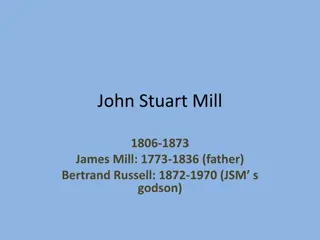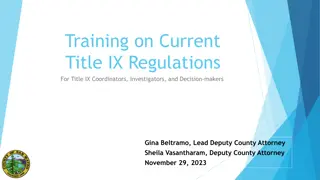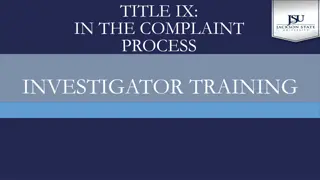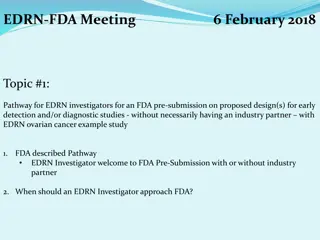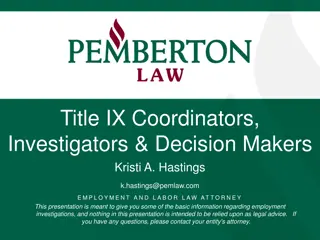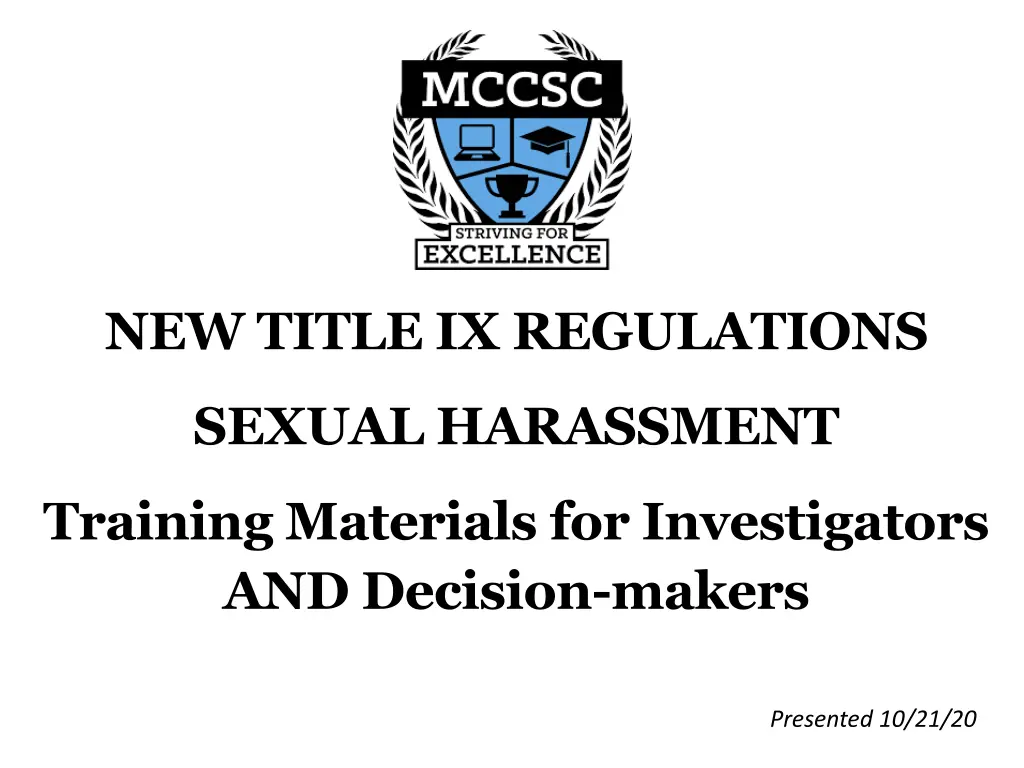
Comprehensive Title IX Regulations Training Materials for Investigators and Decision-makers
Explore in-depth training materials presented on 10/21/20 regarding the new Title IX regulations, covering sexual harassment definitions, investigative processes, impartiality, evidence relevance, and grievance procedures.
Download Presentation

Please find below an Image/Link to download the presentation.
The content on the website is provided AS IS for your information and personal use only. It may not be sold, licensed, or shared on other websites without obtaining consent from the author. If you encounter any issues during the download, it is possible that the publisher has removed the file from their server.
You are allowed to download the files provided on this website for personal or commercial use, subject to the condition that they are used lawfully. All files are the property of their respective owners.
The content on the website is provided AS IS for your information and personal use only. It may not be sold, licensed, or shared on other websites without obtaining consent from the author.
E N D
Presentation Transcript
NEW TITLE IX REGULATIONS SEXUAL HARASSMENT Training Materials for Investigators AND Decision-makers Presented 10/21/20
Why Are We Here? The new Title IX regulations require that all Title IX Coordinators, investigators, decision-makers, and any person who facilitates an informal resolution must receive training. See 106.45(b)(1)(iii).
New Title IX Regulations Require Training on: 1. The definition of sexual harassment in 106.30 2. The scope of the recipient s education program or activity 3. How to conduct an investigation and grievance process including hearings, appeals, and informal resolution processes, as applicable 4. How to serve impartially, including by avoiding prejudgment of the facts at issue, conflicts of interest, and bias 5. Issues of relevance of questions and evidence, including when questions and evidence about the complainant s sexual predisposition or prior sexual behavior are not relevant, as set forth in paragraph (b)(6) of this section 6. Issues of relevance to create an investigative report that fairly summarizes relevant evidence, as set forth in paragraph (b)(5)(vii) of this section
Title IX Grievance Procedures Notes before we start: All timelines are instructional/school days * Asterisk denotes suggestions, not mandated Example: Regulations say prompt response to actual knowledge of harassment. We suggest that means 2 school days. Suggested roles for school staff: Investigator = Title IX Coordinator Decisionmaker = Superintendent Appeal = One school board member, attorney, neighboring superintendent (flexible)
DECISIONMAKER Superintendent INVESTIGATOR APPEAL Title IX Coordinator One school board member 1. Makes ultimate decision 1. Can fluctuate depending on availability/training 1. Lead on investigation (use building-level admin as needed) 2. Hands out discipline if necessary 2. Doesn t taint the entire board if there is a teacher cancellation hearing or student expulsion appeal 2. Responsible for communication with parties
Title IX Grievance Procedures Flowchart
Reports vs. Formal Complaints
Similarities Supportive measures put in place regardless of report or formal complaint Respondent may be removed from an education program or activity on an emergency basis (immediate threat to physical health or safety of any individuals arising from the allegations), whether or not a formal complaint is pending.
Response to Report Response obligations must include: 1. Offering supportive measures to Complainant (alleged victim), and 2. Title IX Coordinator contact the Complainant to discuss the availability of supportive measures with or without the filing of a formal complaint, consider the Complainant s wishes regarding supportive measures, and explain the process for filing a formal complaint.
1. The Definition of Sexual Harassment
Sexual Harassment, Type 1 Sexual harassment means conduct on the basis of sex that satisfies one or more of the following: 1. A school employee conditioning the provision of an aid, benefit, or service of the recipient on an individual's participation in unwelcome sexual conduct This is the quid pro quo (something for something else) type.
Sexual Harassment, Type 2 Unwelcome conduct determined by a reasonable person to be so severe, pervasive, and objectively offensive that it effectively denies a person equal access to the recipient's education program or activity With the 3rd prong covering most everything physical, this prong is focused on verbal or written/electronic forms of harassment. Standard is subjective with respect to the unwelcome-ness of the conduct (i.e., whether the complainant viewed the conduct as unwelcome), but as to elements of severity, pervasiveness, objective offensiveness, and denial of equal access, determinations are made by a reasonable person in the shoes of the complainant.
Why severe and pervasive? Rationale for preventing a hostile workplace environment free from any severe or pervasive sexual harassment that alters conditions of employment does not allow for the social and developmental growth of young students learning how to interact with peers in the elementary and secondary school context and fostering robust exchange of speech, ideas, and beliefs in a college setting. Thus, the Department does not believe that aligning the definitions of sexual harassment under Title VII and Title IX furthers the purpose of Title IX or benefits students and employees participating in education programs or activities. In other words, U.S. Dept. of Education thinks the nature of education means a higher quantity of low grade offensive speech must be tolerated as part of free expression. While non-severe instances of unwelcome harassment may negatively impact a person, and schools retain authority to address such instances, Title IX is focused on sex discrimination that jeopardizes educational access. In other words, U.S. Dept. of Education thinks sex-based conduct toward students must be severe to rise to the level of sexual harassment.
Sexual Harassment, Type 3 "Sexual assault" (as defined by the Jeanne Clery Disclosure of Campus Security Policy and Campus Crime Statistics Act at 20 USC 1092 (f)(6)(A)(v)); "dating violence" (as defined by the Violence Against Women Act at 34 USC 12291 (a)(10)); "domestic violence" (as defined by the Violence Against Women Act at 34 USC 12291 (a)(8)); or "stalking" (as defined by the Violence Against Women Act at 34 USC 12291 (a)(30)).
More on SH Type 3 Fondling, defined under the Clery Act (referring to the FBI s Uniform Crime Reporting system), as the touching private body parts of another person for the purpose of sexual gratification, without the consent of the victim, is the only type of sexual harassment that depends on the intent or purpose of the perpetrator or victim. While the sexual harassment definition does not identify grooming behaviors as a distinct category of misconduct, some grooming behaviors may constitute sexual harassment, and behaviors that do not constitute sexual harassment may still be deemed inappropriate behavior addressed under other areas of policy, procedure, and/or handbook.
2. The Scope of the Recipient s Education Program or Activity
Educational Program or Activity 34 CFR 106.44(a) Schools must respond when sexual harassment occurs in the school s education program or activity, against a person in the United States. Education program or activity includes locations, events, or circumstances over which the school exercised substantial control over both the respondent and the context in which the sexual harassment occurs, and also includes any building owned or controlled by a student organization that is officially recognized by a postsecondary institution.
Triggering Title IX Off-campus incidents incur Title IX response: 1. if the off-campus incident occurs as part of the recipient s operations pursuant to 20 U.S.C. 1687 and 34 CFR 106.2(h); 2. if the recipient exercised substantial control over the respondent and the context of alleged sexual harassment that occurred off campus pursuant to 106.44(a); or 3. if a sexual harassment incident occurs at an off-campus building owned or controlled by a student organization officially recognized by a postsecondary institution pursuant to 106.44(a). If complainant is no longer enrolled when the complaint is filed, or if the perpetrator is no longer enrolled or employed, no reason for the school to do a investigation because the school can t do anything.
Example of Defining Scope For the purposes of Title IX, the scope of the Corporation s educational program or activities includes locations, events, or circumstances over which the Corporation exercises substantial control over both the respondent and the context in which the sexual harassment occurs [only for postsecondary: and also includes any building owned or controlled by a student organization that is officially recognized by a postsecondary institution.] This includes all activities taking place within a school building or on Corporation property; any athletic, extracurricular, or co-curricular activity officially recognized by the Corporation and led by a Corporation employee; computer and internet networks, digital platforms, and computer hardware or software owned or operated by, or used in the operations of, the Corporation.
3. How to Conduct an Investigation and Grievance Process
Non-Disclosure Agreement
Interview Complainant Identify who, what, when, where. Specific descriptions of incident(s) Similar experiences in the past Determine what offended Complainant Impact on Complainant Discuss complainant s response Identify Witnesses What relief is being requested
Other Interviews Potential witnesses named by Complainant Purpose for interview investigating allegations against {Individual} Complainant indicated you might have information Who/when/why/how of what you did or did not witness or hear Ask that they not discuss the interview (NDA) Explain no retaliation for telling the truth In closing Any other information? Contact me if you remember anything, or if observe anything relevant.
Respondent Interview Define the allegation at issue Ask to identify situations where he/she harassed others or engaged in behavior in violation of rule Confront with general allegations Confront with more specifics Note responses Permit him/her to offer evidence/witnesses Ask that they not discuss the interview (NDA) Explain no retaliation against complainant
Other Interviews Potential witnesses named by Respondent Same general questions as other witnesses Ask that they not discuss the interview (NDA) Explain no retaliation against complainant Complainant and/or Respondent (Follow Up) If necessary Clarify allegations and inconsistencies Gather additional information
Review of Records and Evidence Review Personnel/Student Files Look for patterns Prior relationships Review other Contemporaneous Evidence Video Log Sheets Phone and e-mail records Records made at the time of allegations
Analyzing the Evidence Credibility Decisions Bias History of Similar Conduct Corroboration Other Discipline Eye contact, voice tone, demeanor during interviews. Determine if Substantiated Review notes, statements and other evidence
Inspection and Review of Evidence Must provide all evidence, even that not relied upon to the parties for inspection, parties have 10 days to respond Evidence must be directly related to the allegations Non-treatment records and information, such as a party s financial or sexual history, must be directly related to the allegations at issue in order to be reviewed by the other party. School has discretion on how to provide the evidence. May redact information not directly related to the allegations. Confidential information may not be redacted if directly related to the allegations. 106.45(b)(5)(vii)
Investigative Report Create an investigative report that fairly summarizes relevant evidence and, at least 10 days prior to a hearing (if a hearing is required under this section or otherwise provided) or other time of determination regarding responsibility, send to each party and the party s advisor, if any, the investigative report in an electronic format or a hard copy, for their review and written response. 106.45(b)(5)(vii) The regulations do not proscribe how to incorporate the parties response into the final determination.
Submission of Written Questions After the recipient has sent the investigative report to the parties pursuant to paragraph (b)(5)(vii) of this section and before reaching a determination regarding responsibility, the decision-maker(s) must afford each party the opportunity to submit written, relevant questions that a party wants asked of any party or witness, provide each party with the answers, and allow for additional, limited follow-up questions from each party. 106.45(b)(6)(ii)
Determination Must include: Identification of the allegations potentially constituting sexual harassment; A description of the procedural steps taken from the receipt of the formal complaint through the determination, including any notifications to the parties, interviews with parties and witnesses, site visits, methods used to gather other evidence, and hearings held; Findings of fact supporting the determination; Conclusions regarding the application of the recipient s code of conduct to the facts; A statement of, and rationale for, the result as to each allegation, including a determination regarding responsibility, any disciplinary sanctions the recipient imposes on the respondent, and whether remedies designed to restore or preserve equal access to the recipient s education program or activity will be provided by the recipient to the complainant; and The recipient s procedures and permissible bases for the complainant and respondent to appeal.
Optional Hearing For recipients that are elementary and secondary schools, and other recipients that are not postsecondary institutions, the recipient s grievance process may, but need not, provide for a hearing. 106.45(b)(6)(ii) May, but need not provide a hearing for K-12. Footnote in comments indicate decision to hold a hearing could be made on a case-by-case basis.
Its All About the Process OCR and Courts will generally not second- guess the outcome of an investigation, as long as the investigation is done according to policy and appropriate standards READ, RE-READ, ASK QUESTIONS, FOLLOW THE POLICY + PROCEDURES
Follow Up! Retain documentation (7 years) Complete notes and reports Ensure everything signed and dated Check in with Complainant Check in with Respondent (if still employed) Review policies and procedures
4. How to Serve Impartially
Role of Title IX Coordinator Impartial Investigator and Consultant Trained to understand Title IX, analyze whether something rises to level of substantiation Title IX Coordinator s delegates (building administrators, counselors, etc.) conduct on the ground investigation at her delegation Determines if harassment is substantiated based on preponderance of the evidence, writes formal report Coordinates with legal counsel as necessary
Single Investigatory Model Prohibited The decision-maker(s), who cannot be the same person(s) as the Title IX Coordinator or the investigator(s), must issue a written determination regarding responsibility. 106.45(b)(7)(i). Title IX Coordinator not required to investigate, but cannot be the decision maker.
Conflicts of Interest Two types: Legal conflicts (less common in this situation) and Perceived conflicts (more common) Person named as Harasser or Witness Member of investigatory team If district-level administrator, board member, or Title IX Coordinator is named as Harasser or Witness, good idea to call in outside investigator
5. Issues of Relevance of Questions and Evidence
Evidence that Must Be Deemed Irrelevant, with Exceptions Questions and evidence about a Complainant s sexual predisposition must always be deemed irrelevant, and therefore excluded. Questions and evidence about a Complainant s prior sexual history must be deemed irrelevant, and therefore excluded- with two limited exceptions: 1. Where Respondent contends that someone other than the respondent committed the misconduct 2. Where the question(s) or evidence concern incidents between the Complainant and Respondent and are offered to prove consent.
6. Issues of Relevance to Create an Investigative Report that Fairly Summarizes Recent Evidence
Issues of Relevance to Create an Investigative Report Evidence is relevant if it has any tendency to make a fact that is of consequence to the determination of sexual harassment more or less probably that it would be without the evidence. o The evidence must be directed to a matter of consequence, essentially the definition of sexual harassment. o The evidence must be probative it must make something more or less probative. It does not have to be in dispute. Whether something is more or less likely is guided by logic and human experience.
Issues of Relevance to Create an Investigative Report Example: Defendant is bank robbery case was overheard saying he wanted to rob the bank, human experience tells us that when someone says they will do something, they are more likely to do it.

